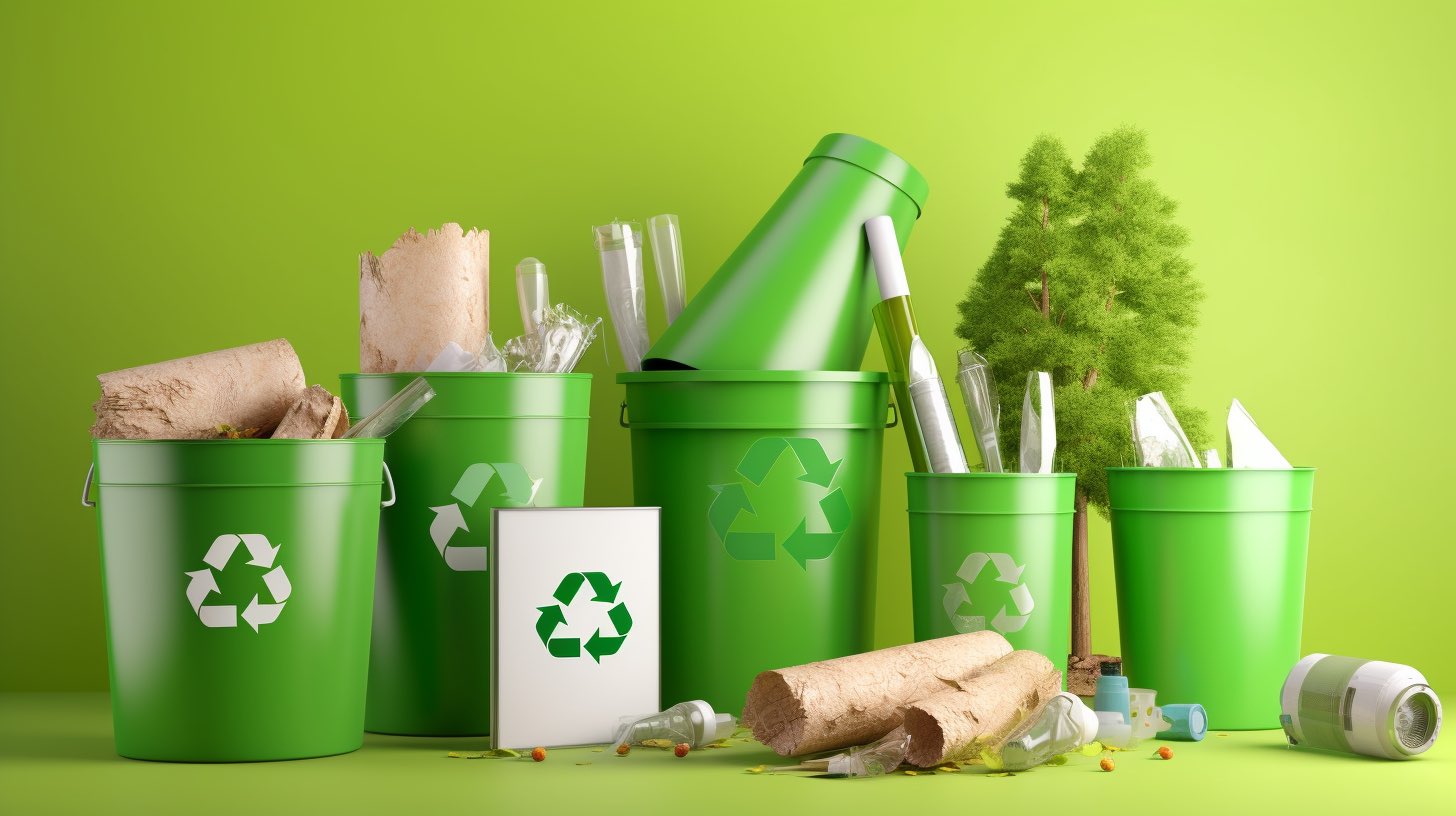As we confront the 21st century’s myriad challenges, the issue of waste management ranks highly among them, posing significant threats to our environment and public health. The concern is even more pressing in Europe, given its population density and industrial activities. Consequently, the need for innovative waste management solutions has never been more apparent. The following discussion details the current state of affairs, shedding light on recent innovations and their importance to the European Union (EU). Additionally, visit our Environmental Protection category to read more posts. Meanwhile, this post is related with our new project we will propose with Mevhibe Ateş Teknoloji Vakfı
The Current Scenario: A Call for Transformation
Although, the EU has been working diligently to tackle its waste management problem. In 2018, the average EU citizen generated 502 kg of municipal waste, 47% of which was recycled or composted [1]. However, the need for more efficient waste management systems is apparent, as large volumes of waste still end up in landfills, leading to soil, air, and water pollution [2].
Innovative Waste Management Solutions: A Glimpse into the Future
Several solutions for waste management have emerged in recent years, addressing the flaws of traditional methods. Here are three significant innovations:
Waste-to-Energy (WtE) Technologies
Transforming waste into an energy source is an increasingly popular solution. WtE technologies, such as anaerobic digestion and incineration, convert waste into heat, electricity, or fuel. It mitigates landfill usage and contributes to energy generation [3].
Waste-to-Energy (WtE) technologies refer to several methods to convert municipal and industrial waste into energy. This energy typically takes the form of heat, electricity, or fuel. The primary purpose of these technologies is to reduce the volume of waste that ends up in landfills while also generating valuable resources.
Let’s break down some standard WtE technologies:
Incineration: The Dominant Waste-to-Energy Method
Incineration stands out as the most common Waste-to-Energy (WtE) method. This process involves burning waste at extremely high temperatures. Subsequently, the heat generated powers steam production, driving a turbine linked to a generator. In turn, this setup creates electricity. Incineration is a compelling option with its ability to reduce waste volume by an impressive 85-90%. However, it’s not without controversy due to potential pollution. Today’s incinerators strive to burn as cleanly as possible. They are also equipped with filtration systems to capture any pollutants.
Gasification: Power from Carbonaceous Materials
Next, we have Gasification. This method transforms organic or fossil fuel-based carbonaceous materials into carbon monoxide, hydrogen, and carbon dioxide. The process involves reacting the material at high temperatures but without combustion. The outcome is a gas mixture known as syngas, a valuable fuel. Syngas can generate electricity or act as a vital chemical in the petrochemical and refining industries.
Pyrolysis: Energy from Heat Decomposition
Then there’s Pyrolysis. In this process, waste undergoes heating in an oxygen-free environment, breaking it into a mix of gases, liquids, and some solid residue. These products can be used to generate energy or further processed to create other useful products.
Anaerobic Digestion: Tapping into Biological Process
Anaerobic Digestion is a biological process where bacteria break down organic wastes, such as food and manure, in an oxygen-free environment. This process yields biogas (a combination of methane and carbon dioxide), which can be utilised as a fuel. It also produces a nutrient-rich biofertiliser.
Landfill Gas Capture: Harnessing Methane from Decomposition
While Landfill Gas Capture is not a WtE technology per se, it’s worth mentioning. As organic waste decomposes in landfills, it emits a significant amount of methane, a potent greenhouse gas. This methane can be captured and repurposed as a fuel for generating electricity or heat.
WtE technologies promise a significant role in sustainable waste management and energy production. Still, they also present hurdles, such as high upfront costs, technological complexity, and potential environmental impacts. Hence, careful planning and management are essential when implementing these technologies. Each method is best suited to different types of waste and comes with varying efficiencies and environmental impacts. Consequently, the choice of technology hinges on several factors, including waste composition, volume, local regulations, and the market for the energy produced.
Innovative Waste Management
Transitioning into a new era, innovative waste management practices, such as integrating the Internet of Things (IoT) and Artificial Intelligence (AI), are making a significant difference.
IoT: A Revolutionary Approach to Waste Management
At the heart of this transformation, we find IoT. This technology offers real-time monitoring of waste levels in bins, enabling more intelligent decision-making. IoT-connected sensors placed inside trash containers provide accurate data on waste levels. Thus, waste management companies can optimize their collection routes, saving time, and resources and reducing CO2 emissions.
Additionally, IoT devices help segregate waste at the source, increasing recycling rates. These devices enhance waste treatment efficiency by identifying the type of waste, contributing to a circular economy.
AI: The Future of Waste Management
AI’s introduction into waste management further empowers this sector. AI can analyze large datasets from IoT devices, predict waste generation trends, and suggest the most efficient waste collection routes. Consequently, it leads to a highly optimized, data-driven waste management process.
Moreover, AI can revolutionize recycling. Advanced AI-powered robots can quickly sort waste, reducing contamination levels in recycled materials. It also makes the process faster and more efficient, fostering a more sustainable environment.
In conclusion, integrating IoT and AI into waste management is more than just a technological advancement. It’s a step toward a cleaner, more sustainable world. As we continue to innovate, we’ll see these technologies play an even more significant role in managing waste, ensuring a better future for all.
Innovative Waste Management Solutions: Circular Economy Models
The circular economy concept promotes “closing the loop” of product lifecycles by recycling and reusing materials. This approach reduces waste generation and stimulates economic growth.
The Importance of Innovative Waste Management Solutions in the EU
The adoption of innovative waste management solutions is crucial for the EU for several reasons:
Environmental Protection:
Innovative solutions reduce landfill usage and associated environmental pollution, thus contributing to cleaner air, water, and soil.
Energy Generation:
WtE technologies offer an alternative energy source, aligning with the EU’s renewable energy goals.
Economic Growth:
Implementing a circular economy can create new jobs and stimulate economic growth.
Climate Change Mitigation:
The EU can significantly reduce its greenhouse gas emissions by reducing waste and converting it into energy.
Conclusion
Implementing innovative waste management solutions is an urgent requirement for the EU. While progress has been made, further research, development, and regulatory support are needed to promote these technologies and models. By doing so, we can protect our environment, contribute to economic growth, and secure a sustainable future for the EU.
References
[1] Eurostat (2019). “Municipal waste statistics.” Available at: https://ec.europa.eu/eurostat/statistics-explained/index.php?title=Municipal_waste_statistics
[2] Kalmykova, Y., Sadagopan, M., & Rosado, L. (2018). “Circular economy – From review of theories and practices to development of implementation tools.” Resources, Conservation and Recycling, 135, 190-201.
[3] Malinauskaite, J., Jouhara, H., Czajczyńska, D., Stanchev, P., Katsou, E., Rostkowski, P., Thorne, R.J., Colon, J., Ponsá, S., Al-Mansour, F., Anguilano,















